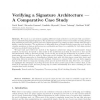Free Online Productivity Tools
i2Speak
i2Symbol
i2OCR
iTex2Img
iWeb2Print
iWeb2Shot
i2Type
iPdf2Split
iPdf2Merge
i2Bopomofo
i2Arabic
i2Style
i2Image
i2PDF
iLatex2Rtf
Sci2ools
FAC
2007
2007
Verifying a signature architecture: a comparative case study
Abstract. We report on a case study in applying different formal methods to model and verify an architecture for administrating digital signatures. The architecture comprises several concurrently executing systems that authenticate users and generate and store digital signatures by passing security relevant data through a tightly controlled interface. The architecture is interesting from a formal-methods perspective as it involves complex operations on data as well as process coordination and hence is a candidate for both data-oriented and process-oriented formal methods. We have built and verified two models of the signature architecture using two representative formal methods. In the first, we specify a data model of the architecture in Z that we extend to a trace model and interactively verify by theorem proving. In the second, we model the architecture as a system of communicating processes, which we verify by finite-state model checking. We provide a detailed comparison of the...
Architecture | FAC 2007 | Formal Methods | Model |
Related Content
| Added | 14 Dec 2010 |
| Updated | 14 Dec 2010 |
| Type | Journal |
| Year | 2007 |
| Where | FAC |
| Authors | David A. Basin, Hironobu Kuruma, Kunihiko Miyazaki, Kazuo Takaragi, Burkhart Wolff |
Comments (0)

